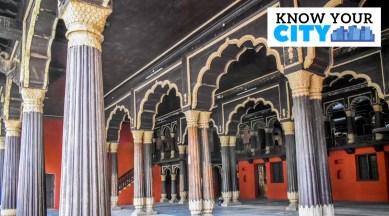Stay updated with the latest - Click here to follow us on Instagram
Know Your City: Tipu’s Summer Palace, an echo of the Tiger of Mysore in modern Bengaluru
The Kote Venkataramana Temple was also built around this time, and still stands today next to the summer palace, which is situated near KR Market

“As soon as the foundation of this palace was laid, its head was raised to heaven with joy. Oh, what a lofty mansion, a home of happiness, its summit being above the skies. It is a house of glass in purity, all who see it are struck with wonder.”
A stone’s throw away from KR Market, the Tipu Sultan’s Summer Palace in Bengaluru has this inscription in Farsi at the entrance. Today it abuts a main road. But once upon a time, it was part of the larger structure of the Bangalore Fort, which was expanded in the late 17th century by King Chikkadevaraja Wodeyar I to counter the risk of Maratha raids (he had already come into conflict with Chhatrapati Shivaji on one occasion). The Kote Venkataramana Temple was also built around this time and still stands today next to the summer palace.
monthly limit of free stories.
with an Express account.
The construction of the palace itself was begun by Mysore ruler Hyder Ali and finished by his son Tipu Sultan in 1791. The British took over the complex in the wake of Tipu’s final defeat. At the time, the palace was far larger than the single building which survives today, according to the Indian National Trust for Art and Cultural Heritage. It encompassed a parade ground for Tipu’s soldiers, fountains, gardens, and a much larger palace structure. What survives today primarily served as a court of audiences and durbars, whilst the remainder of the palace eventually deteriorated and was demolished.
From around 1831, the administration of the state of Mysore was headquartered here, along with no less a figure than Sir Mark Cubbon, the British army officer with the East India Company. The administration was later moved to the Attara Kacheri after it was constructed in 1868 – a building which we today know as the Karnataka High Court.
The architecture of the surviving palace also displays a unique blend of Islamic architecture and South Indian styles, particularly characterised by the teak pillars and the cusped arches that extend between them. The building is essentially based on a low stone platform with 160 of these pillars spread throughout and is mostly made of wood. Remnants of beautiful floral and geometric artwork remain on the walls in places. However, much of this has worn away over time, and regrettably, has also been heavily defaced in areas by modern visitors carving graffiti into the walls.
Visitors can also walk into a small gallery on the ground floor with informational bulletins posted by the Archaeological Survey of India, along with replicas of Tipu’s rockets as well as a model of Tipu’s Tiger, an automaton depicting a tiger eating a European (the original is on display in the British Museum). The replicas of period sketches by British artist James Hunter can also be seen here, which give the viewer an idea of what the surrounding area looked like before it was urbanised.
On the first floor, one can see the balcony where Tipu would have received visitors and held court, while the front of the palace would have probably hosted musical performances.
The palace is open to visitors on all days of the week from 8.30 am to 5.30 pm. Tickets cost Rs 20.